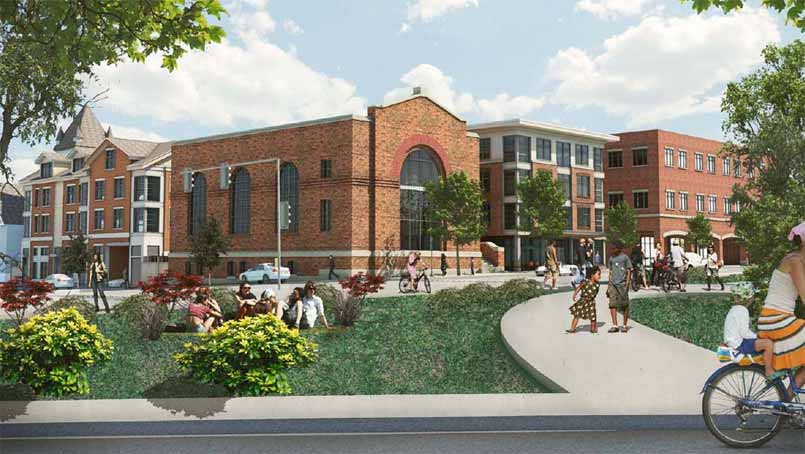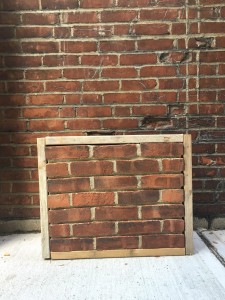
08 Jun Attention to detail ensures a successful brick restoration project
The Historic Roslindale MBTA Substation being developed by Peregrine Group LLC in partnership with HBI and Roslindale Village Main Street will be undergoing brick masonry restoration work through this summer. We asked Lincoln Andrews, fourth generation owner of The Stiles & Hart Brick Co, to comment on brick matching and restoration work.
Brick is an integral part of Boston’s history. Many of Boston’s most iconic buildings are made from colonial brick. This will explore a few of those iconic buildings and the process behind their restoration and preservation.
There are two methods of making brick — molded and extruded. Molded brick are used on virtually all of Boston’s historic brick buildings. The Old State House (circa 1713), site of the infamous Boston Massacre, is a prime example.
Molded bri ck are made by taking “Boston Blue Clay” and pressing it into mold. The mold is inverted, allowing the brick shaped piece of clay to fall out. The green brick is then allowed to dry and placed into a kiln, where it is fired until impervious to the elements. Extruded brick is a more modern process, where clay comes out of an extruder, similar to pasta coming out of pasta machine. The extruded piece of clay is cut into uniform segments. In broad terms, molded brick have colonial imperfections, and extruded brick are more mechanically precise. The matching and restoration of The Old State House was an exhaustive process, as the brick vary widely. The wide varieties of brick meld into a beautiful kaleidoscope of colors, with the restoration and individual brick going unnoticed.
ck are made by taking “Boston Blue Clay” and pressing it into mold. The mold is inverted, allowing the brick shaped piece of clay to fall out. The green brick is then allowed to dry and placed into a kiln, where it is fired until impervious to the elements. Extruded brick is a more modern process, where clay comes out of an extruder, similar to pasta coming out of pasta machine. The extruded piece of clay is cut into uniform segments. In broad terms, molded brick have colonial imperfections, and extruded brick are more mechanically precise. The matching and restoration of The Old State House was an exhaustive process, as the brick vary widely. The wide varieties of brick meld into a beautiful kaleidoscope of colors, with the restoration and individual brick going unnoticed.
Color range, texture and size are essential to properly restoring brick exteriors and interiors on Boston’s historic buildings. Restoration Brick used on the Old South Meeting House (circa 1729), location of the seeds of revolution and the Boston Tea Party, required a deeper red range of brick with a smaller size. Brick sizes were not standardized, meaning that different buildings from the same period could have substantially different brick in height, length and width. Brick used to patch areas must be sized to match coursing, with similar texture and color to blend in. If any of these facets are off, a distinct outing of the restoration will be visible.
Quincy Market (circa 1824) has visitors from all over the world who see the beautiful Greek Revival building with the soaring dome covered rotunda. While the exterior is largely Granite, few consider the extraordinary efforts needed to maintain the historic integrity of the interior red brick. In 2016, a restoration was performed using five blends of brick and two different sizes.
The African Meeting House (circa 1806), located in Beacon Hill, is a National Landmark and was the first African American Baptist Church in Boston. The intensive restoration of this building was observed by The History Channel’s series “Saving Our History.” A full documentary was produced on the process, including how Stiles & Hart produced thousands of brick with special length, width, height, and color. Many restoration specialists now ask for African Meeting House Brick.
The Massachusetts State Capital (circa 1798) was designed by the renowned architect Charles Bulfinch in the Federal style. While the red brick facade was painted white in 1825 it was exposed once again in 1928. The interesting choice of brick color was a major component of the overall aesthetic. The brick are on the soft red side of the color spectrum. Ironically, the brick would no longer meet current American Society of Testing Materials (ASTM) standards but Bulfinch seems to have understood brick better than most current engineers. The building performed wonderfully for over 200 years and needed only minor replacement. Stiles and Hart initially refused to provide product because of current superfluous standards. Rational minds persevered and a waiver was granted in order to allow the proper brick for a proper restoration.
The Historic Roslindale MBTA Substation (circa 1911) introduces its own set of challenges for brick matching, somewhat similar to the State Capital, as it was built with brick that are a softer red. 110 years of exposure has given the brick a patina and some soot coloration from various sources. Fortunately Stiles & Hart makes a brick to specifically accomplish a proper match. The Roslindale MBTA Substation requires four different colors (one of them being Light Charcoal Waterstruck) and two different brick sizes to meet the three point criteria for a proper match. Attention to detail in the selection and manufacture of the brick is important to ensuring that the Roslindale Substation will be properly restored.
A restoration is most successful when few people notice the difference between existing and new brick.
While walking through Boston take time to lift your head and look at the brick on old buildings. You will quickly observe that old buildings used different ranges and sizes.? Most importantly, you will now be able to recognize if the brick restorations were properly performed.
-Lincoln D. Andrews, President, The Stiles & Hart Brick Co.
Here is a link to the History Channel’s documentary on brick restoration featuring Stiles & Hart Brick and The African Meeting House. https://www.youtube.com/watch?v=Xnow_5q7aXQ&app=desktop
About the Writer:
Lincoln Andrews is the fourth generation owner of The Stiles & Hart Brick Co, founded in 1893. It is Massachusetts only manufacturer of brick. The company specializes in historic restorations and works with the finest architects in the world to produce complex buildings throughout New England. Most of Boston has been paved with their exclusive “Boston City Hall Pavers.”



